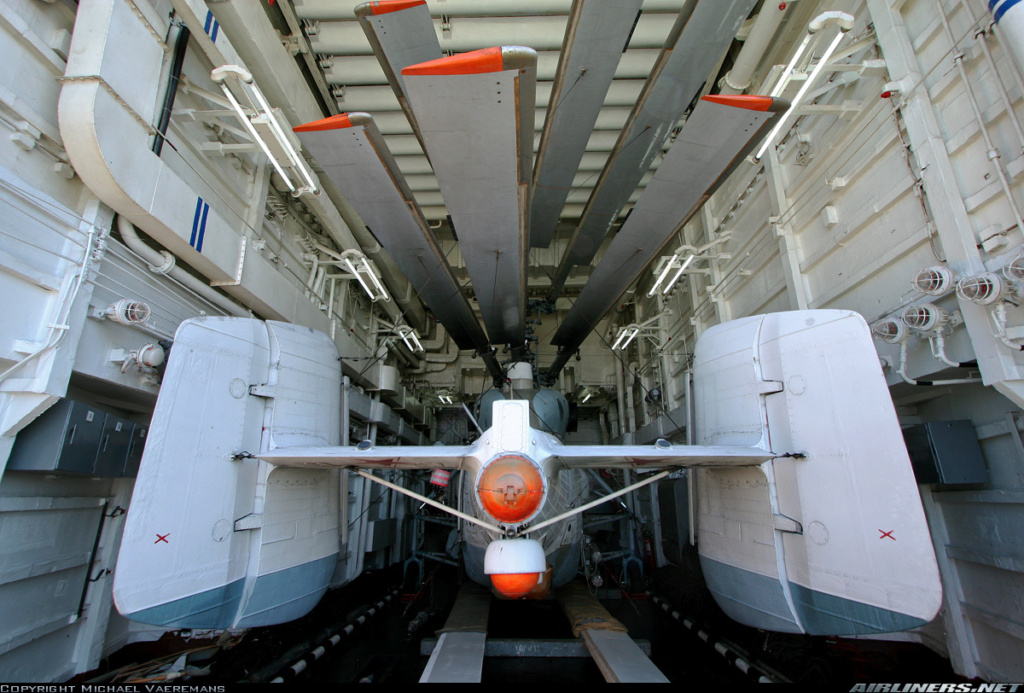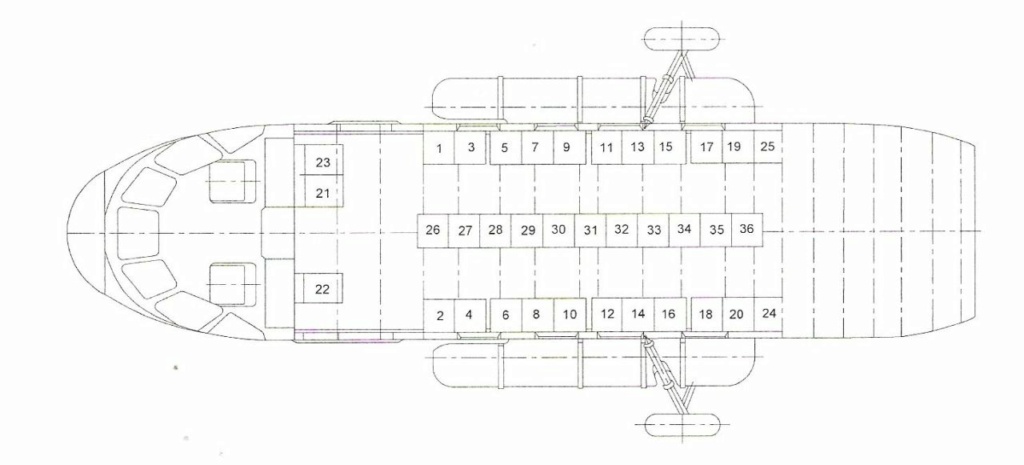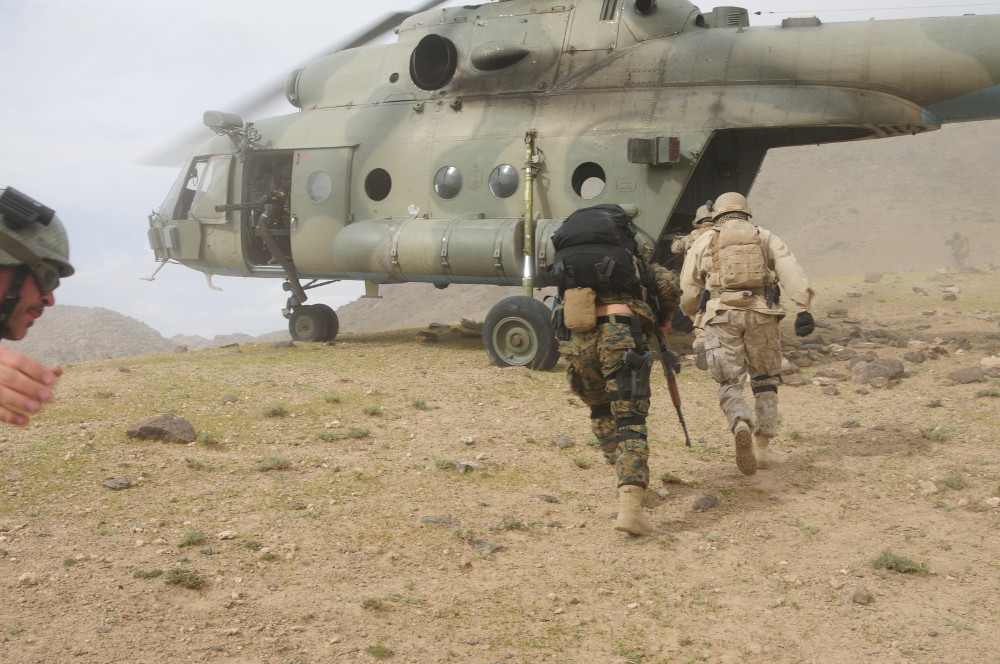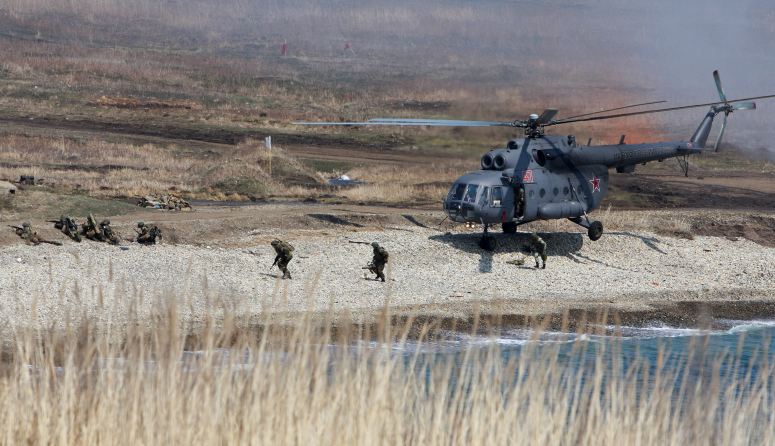Why are people against varan so much?
At 24 fighters it's not that different from kuznetsov either in terms of carrying aircraft

Arkanghelsk wrote:Kuznetsov itself is not really bigger than varan at all, a comparison of the displacement reveals a difference of maybe 5000-10000 tons when kuznetsov is fully loaded.
Why are people against varan so much?
At 24 fighters it's not that different from kuznetsov either in terms of carrying aircraft
GarryB and Mir like this post
If the Argentines had MiG-23s with BVR missiles those Sea Harriers would have been in serious trouble... and the Yak-38 was a joke.
lets look at the history of cheap solutions to the problem of expensive carriers... the Hermes class, the Kiev class
Fighter planes are not ideal for anti sub.... a helicopter carrier can have Mi-14 equivalent aircraft as well as helix based and minoga replacement models too... with a big crane on the front it could even operate amphibious aircraft based on the Be-200... but smaller... that could fly out to a contact and land on the water and put a dipping sonar into the water and use torpedoes and depth charges...

PapaDragon wrote:GarryB wrote:Amusing you think a smaller lighter less capable ship than a Kuznetsov is better... better for what exactly?...
Better for floating above surface, better for sailing on the surface, better for moving under it's own power, better for not being on fire, better for carrying combat aircraft, better for launching combat aircraft, better for retrieving combat aircraft
Some other things as well but this is the gist of it
Mir likes this post
Better for floating above surface, better for sailing on the surface, better for moving under it's own power, better for not being on fire, better for carrying combat aircraft, better for launching combat aircraft, better for retrieving combat aircraft
Some other things as well but this is the gist of it
Kuznetsov itself is not really bigger than varan at all, a comparison of the displacement reveals a difference of maybe 5000-10000 tons when kuznetsov is fully loaded.
Why are people against varan so much?
At 24 fighters it's not that different from kuznetsov either in terms of carrying aircraft
A Syrian-Russian shipyard in Tartus or Latkatia with a dry dock or a floating dock (from Turkey).
This allows a construction of the Varan or Kuznetsov class to be made possible. Large components via transport via Black Sea or Northern Sea. (Modular construction)
So the Mediterranean fleet could be left completety there.
Just a dock for the escort ships, a hall for submarine construction (small hunting submarines) to the same time buyan-M kits for the Syrian Navy.
If anything this is a more modern replacement for the large amphibious LHDs.
It should be noted that I'm not the world's greatest fan of VTOL aircraft, but these aircraft had a role to play . During the early development the US and the French had some interesting concepts that came to nothing.
The naval variant of the British Harrier was optimized for air defense, whilst the Yak-38 was a light strike fighter which makes it rather difficult to compare the Yak-38 with the Sea Harrier.
On sheer performance the Yak-38 was significantly faster than the Harrier at 1280km/h vs 1065km/h but the Harrier had a slightly better range and could fly 100kms further. The Sea Harrier on the other hand had a much better max takeoff weight at 17 600 vs 11 300.
Both were quite difficult to fly according to the guys who actually flew these things. The Harrier has a very long list of accidents through the years. India alone lost 16 out of 31 Sea Harriers that claimed 7 pilots over the years. About a third of the Yak's were lost in accidents.
The Kiev had it's issues but it was quite an unique ship and true to Soviet tradition it was a heavily armed Cruiser that also happened to carry aircraft.
More interesting is that the Kiev was chosen in favour of the Pr.1153 Orel carrier design as it was the cheaper option! The Orel was a super carrier similar in size to the US Kitty Hawks but was also considered to be an Aircraft Carrying Cruiser by the Soviets - not just for legal reasons - as it was also armed with 24 cruise missiles. The one thing I liked about Soviet ships is that they were well armed to defend themselves. I hope the Russians would continue this tradition.
Mi-8 or Mi-38 size would be too large for Russian Navy carrier needs - land based Mi-14 types would be great though. The Minoga should replace the Helix in future.Mi-8 or Mi-38 size would be too large for Russian Navy carrier needs - land based Mi-14 types would be great though. The Minoga should replace the Helix in future.
The Varan carrier is not going to be the sole type of aircraft carrier the Russian Navy would eventually want to build but the design concept is pretty sound and affordable and that is why the Navy is already taking a serious interest in the concept - and not just as a mini aircraft carrier.
Current ones are way, way underpowered, which explained everything from mobility to black smoke). And the reason for that is mostly lack of funding. So if they have enough funding now, it would most likely go to the Kuznetsov than a new carrier.
But the Varan is, well, a bit small for that Smile I wouldnt be surprised if one day they decided to build a carrier that looks exactly like the Varan but with only UAVs
Broski likes this post
The Yak-38 was intended mainly for shooting down enemy MPA aircraft, and its strike capacity was pathetic... the Vulkan missiles on the Kiev class carriers it operated from were much more potent anti ship weapons.
Hard to say with models but the Minoga looks like a coaxial Mi-38 in terms of body size, so it might be a naval Mi-14 and Helix replacement all in one... a sort of massively scaled up Ka-226..
The Minoga should be similar in size to the current Helix.
I compared the Yak-38 to the Sea Harrier as they were both intended for carrier operations but to be fair to the Yak it should rather be compared to the GR series of the Harrier. Both were light strike fighters (as I've mentioned) with basically the same capabilities although the Harrier could carry a heavier load.
Just had a quick peek on Harrier losses vs the Yak-38. I've mentioned above that a third of the Yak's were lost in accidents but it seems to be much less than that with less than 50 aircraft. Some of the accidents occurred after the Yak's were withdrawn from service.
I've also mentioned the Harrier's very long list of accidents since the 60's which equals the entire production run of the Yaks at 230+ losses! Six US Harriers that were destroyed on the ground by militant action are not included in the tally.
Similar cross section to the Mi-38 and not needing the very long tail... the fuselage will likely be extended to something closer to the Mi-38, and likely a rear ramp door will be fitted to improve entry exit options... and of course it will need more powerful engines...

Doesn't matter which version of Harrier you compare it to... the Yak was a dog... no radar and basic armament... not a capable aircraft in any sense of the word.
The GR's had no radar either and compared tot the Gr1 version the earliest Yak-38 could launch air to surface missiles - not so with the Gr1. The Yak was more or less equal to the Gr3 version and only outclassed by the latter Harrier II (GR5/7/9)variants.
By then the far more capable than any Harrier Yak-41 was set to replace the Yak-38M.
That image of the Helix highlights how narrow the fuselage of the helicopter is... a Coaxial rotor helicopter does not need a long tail, so making the body wider and having a longer body with internal cabin space that ends at the rear with a large ramp door is what I expect they will be aiming for.
Side doors only is limiting... a Hind and a Blackhawk and a Helix only have side doors which limits the speed you can get on or off each helicopter... and having a rear ramp door means you can carry small vehicles internally too which is another bonus as well as allowing a rear gunner as well as side door gunners in dangerous airspace.

The Yak was only ever deployed on Kiev class ships operationally which are large anti submarine carriers... their opportunity for using air to surface missiles was extremely limited...
The Yak was tested in Afghanistan in the light ground support role, where it failed terribly... dust was a problem...
The Yak-141 had some potential, but it was never anywhere close to operational..

GarryB wrote:Current ones are way, way underpowered, which explained everything from mobility to black smoke). And the reason for that is mostly lack of funding. So if they have enough funding now, it would most likely go to the Kuznetsov than a new carrier.
Half were replaced just before going to Syria, and the rest were replaced after it had been in Syria so it should be pretty good now.
GarryB wrote:
A Varan type purely for launching UAVs... VSTOL ones, conventional take off ones, sea surface ones and submersible ones... would make sense... except they are already talking about one helicopter carrier and one UAV platform for the Ivan Rogov class... so four to be made with two UAV platforms and two helicopter landing ships... what do we need the Varan for again?
If the picture was taken from the opposite side you would probably comment on how wide the fuselage is
However the fuselage is not the problem though - the undercarriage determines the actual width of the ship-born helicopter. The Helix sits quite wide at 3.8m whilst the Mi-38 width is 4.5m.
South Africa used the Puma/Oryx helicopters extensively during the bush war and those big side doors on either side of the helicopter allowed troops to exit much quicker than the ramp door on the Super Frelon. The troops also had a great view of what was going on on the ground.
Even the earlier Yak-36M's could hit targets 10kms away with the Kh-23!
There is a documentary on it but you can read this very interesting story here >>
This machine proved itself as remarkable aircraft in British-Argentinean conflict for Falkland Islands. - No doubt that Harrier finished the Falklands. If there were no Harriers it's not quite obvious how this would end. - That's a fact and no one can do anything about it.
If things were a little different you would have seen the supersonic Yak-41's operational on the Kiev carriers - giving these carrier a much better air component.
Not quite. The turbines with correct power output are to be installed in its ongoing upgrade, along with other stuff like automated landing system. Before going to Syria they replaced an old underpowered model with a new yet still underpowered one.
I've always thought that the Ivan Rogov was both a helicopter carrier and UAV platform because it's an amphibious assault ship.
The Varan can then be a more dedicated carrier to deploy air wings and heavy UAVs.
Isos wrote:Carriers won't affect WW3 anyway. This design is good.
Weapons onvoard are not that much needed since it will always be escorted.
Few pantsir and Paket-NK is the minimum to have.
The real weapon of carriers are the jets onboard. Many seem to foget that...
Not at all, the problem is not perspective... you can see the narrow width of the body of the aircraft... a little distorted by the fisheye lens, but the rear tail surfaces stick out to the width of the stub wings in their folded position which stick out quite a bit from the fuselage sides.
Making the fuselage 1m wider and say 3 metres longer that ends in a ramp tail exit with side fins sticking out that can fold back in to the body of the helicopter would massively increase the internal cabin space of the platform and improve access and exit options without taking up a lot more space inside their hangars.

It could have retractable outrigger gear that folds to a narrower wheel base when being moved into a hangar... for landing and takeoff it could extend outwards to provide extra stability.
The country that produced the work of art that is the MiG-23s undercarriage could do it...
But no view behind and no ability to drive light vehicles on board... and there only being two entrances and exits it of course would be slower than with three.

Thanks for that... seems very sympathetic to the Yak though...
The Yak-141 was an experiment that didn't produce anything useful.
LMFS likes this post
These hangers are quite limited when it comes to space but let's see when they roll out the new ship-born helicopter. No point in speculating the same point over and over again with no real prototype in hand.
Retractable gear of any kind would add a lot of weight to the helicopter - something the designers are looking to avoid in official statements.
The idea is to fit the helicopter with more powerful engines but also make it much lighter than the Ka-27 by using composites.
Later Mi-24 versions have non retractable landing gear in order to just that - significantly reducing weight.
Russians and Soviets seems to prefer using the side door for entrance and exit of troops - even in simulated combat situations.



The rear clam shell door seems to be reserved for vehicles only. You are welcome to prove me wrong with some photographic evidence on the Mi-8 or even the old Mi-4.
Not really - he just tells it as it was - problems included.
Bollox! There was nothing experimental about the Yak-41 - it was set to replace the Yak-38's.
The Yaks could take off vertically from the Kiev carriers with an interval of 5-7 seconds, while the British could only lift 4 aircraft into the air per minute. Thus, in a minute 6-10 Yaks would have been in the air against 4 Harriers.
The low takeoff rates of British aircraft were associated with the design feature of starting the engine through the APU whilst the Soviet Yaks were launched from the ship's onboard power supply.
The Yak was also able to use air to surface missiles - something the early Harrier could not do.
Another significant advantage of the Yak was the unique SK-3M pilot rescue system, which allowed the pilot to be automatically ejected when things went pear shape.
Since the introduction of the Sea Harrier FRS2 and the other Harrier II's it became clear that a replacement for the Yak-38M was urgently needed.
The Yak-41 had a much more powerful avionics kit consisting of a pulse-Doppler radar , a laser rangefinder and electronic warfare equipment located in the wingtips and fuselage of the aircraft.
The R79V-300 thrust vectoring engine became the first engine in the world that allowed the use of afterburner both in horizontal and vertical flight modes. Thanks to the unique design of the main engine, the Yak-41 became the second aircraft after the French experimental Dassault Mirage IIIV, VTOL flying at supersonic speed.
The Yak-41's weapons systems was also much more diverse and more powerful than the Yak-38M and even the Harrier II. It was created as an all-weather multi-role aircraft for the Air Force (Yak-43) and Navy aviation. The Yak-43 differed from the Yak-41 in that it had a shorter takeoff (with a run-up length of 120 meters) and had a longer combat radius. The Yak-43 was also a more stealthy design with internal weapons.
Armament included the GSH-30-1 cannon, R-27, R-60, R-73 and R-77 air-to-air missiles and the Kh-25, Kh-31 and Kh-35 air-to-surface missiles on its four under wing hard points.
It was a true multi-role fighter.
Most importantly, these tests demonstrated complete superiority over the Harrier in all major aspects.
A few days later the first take-off was performed but it ended in a heavy crash on the landing approach. The pilot ejected safely. Accidents like these are not uncommon during development
Despite this the then renamed Yak-141 was displayed at the Farnborough-1992 exhibition in all its glory. This resulted in the Yakovlev OKB's participation in a joint project with Lockheed to develop the JSF (Joint Strike Fighter) program.
Since 2017 rumours have surfaced that the Yakovlev OKB is planning the next generation VTOL fighter for the Russian Navy and it may well be based on the Yak-201. It looks a lot like the VTOL aircraft depicted on the pictures I posted of the Varan. We'll see?
Mi-17s have doors on both sides and a rear ramp...


I mean retractable gear in the sense of foldable rotors. The gear only needs to stick out and form a wide ground base during landing and takeoffs for stability. Just like the blades need to be deployed and spinning when taking off, flying and also landing, but when putting it away in a hangar you can fold the blades and shift the widely spread position of the main gear closer to the body of the aircraft so it will fit into a smaller area that is a hangar.
The Yak-38 could have been replaced by a Ka-52... in fact a Ka-52 would be orders of magnitude better than the Yak-38.
The Yak-41 was never going to be better than a MiG-33. It was a dead end design.
Statistics bullshit is just bullshit... for it to be important the British carrier and the Soviet carrier would need to be sailing around with their eyes closed waiting for someone to say go to start launching planes.... and in that case the Yaks might get airborne faster than the Harriers, but considering they operate in the real world any enemy force of aircraft will be detected at significant ranges and a suitable number of fighters will be sent up to intercept them... in that case it is not launch rate, but carrier capacity that matters, and there were vastly more Harriers made and used than Forgers.
GarryB likes this post
GarryB likes this post
lancelot wrote:Oh. That. They both sucked.
Sorry.
Only aircraft which killed more pilots was probably the F-104 Starfighter.
Don't get me wrong it is an amazing achievement to make a VTOL jet aircraft. But then again so would be making a working ornithopter. Does not mean I would want to fly in one.
Isos wrote:Indians have lost hundreds of pilots because of mig-21 crashes.
GarryB likes this post